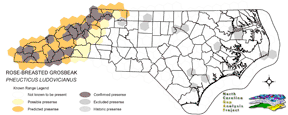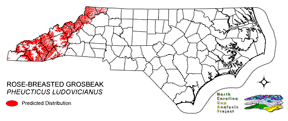
| Taxa: |
| Order: |
| Family: |
| Aves |
| Passeriformes |
| Cardinalidae |
| NatureServe Global Rank: |
| NatureServe State (NC) Rank: |
| G5 |
| S4B,SZN |
| Federal Status: |
| NC State Status: |
| --- |
| --- |


| Land Unit |
| US Fish & Wildlife Service |
| US Forest Service |
| US National Park Service |
| US Department of Defense |
| NC State Parks |
| NC University System |
| NC Wildlife Res. Com. |
| NC Forest Service |
| NC Div. of Coastal Mgmt. |
| Local Governments |
| Non-Governmental Org. |
| Other Public Lands |
| Private Lands |
| GAP Status 1-2 |
| All Protected Lands |
| Statewide |
| Hectares |
| 0.00 |
| 263,008.08 |
| 0.00 |
| 87,424.02 |
| 2,490.57 |
| 82.80 |
| 3,387.96 |
| 1,598.31 |
| 0.00 |
| 6,624.90 |
| 5,126.31 |
| 38.43 |
| 548,711.10 |
| 121,706.73 |
| 369,440.37 |
| 918,492.48 |
| Acres |
| 0.00 |
| 649,906.99 |
| 0.00 |
| 216,029.42 |
| 6,154.33 |
| 204.60 |
| 8,371.83 |
| 6,177.02 |
| 0.00 |
| 16,370.48 |
| 12,667.39 |
| 94.96 |
| 1,355,894.39 |
| 302,971.33 |
| 915,134.36 |
| 2,271,871.41 |
| % of Dist. on |
| Prot. Lands |
| 0.0 % |
| 71.2 % |
| 0.0 % |
| 23.7 % |
| 0.7 % |
| < 0.1 % |
| 0.9 % |
| 0.4 % |
| 0.0 % |
| 1.3 % |
| 1.3 % |
| 0.0 % |
| 0.0 % |
| 32.9 % |
| ----- |
| ----- |
| % of Dist. on |
| All Lands |
| 0.0 % |
| 28.6 % |
| 0.0 % |
| 9.5 % |
| 0.3 % |
| < 0.1 % |
| 0.4 % |
| 0.2 % |
| 0.0 % |
| 0.7 % |
| 0.6 % |
| < 0.1 % |
| 59.7 % |
| 13.3 % |
| ----- |
| ----- |
|
Uncommon to common from middle to high elevations in the mountain region (Simpson 1992). Found in second growth (Ehrlich et al. 1988), medium, or mature deciduous forests (Simpson 1992) with a medium to dense understory (Nicholson 1997), or wherever there is a dense growth of trees and shrubs along the margin or a forest, pasture, or stream (Bent 1968). Has also been known to nest in heath balds and abandoned strip mines (Nicholson 1997). Nest is placed in a shrub or small tree, from 5 to 50 feet above the ground. Forages by gleaning and hawking insects and eating fruit from tree branches, but will also forage on the ground. Females tend to forage higher in the canopy than do males (Ehrlich et al. 1988). NATURE SERVE GLOBAL HABITAT COMMENTS: Second-growth woods, mature forest edge, borders of swamps and wooded streams, dense growths of small trees, gardens and parks, old orchards. In migration and winter in various forest, woodland, and scrub habitats; avoids interior of closed forest. Usually remains high in trees but sometimes descends to ground (Stiles and Skutch 1989). Nests usually in thickets or small trees, generally 2-5 m above ground. |
| Code | Name | Description | NC Natural Heritage Program Equivalent |
| 230 | Piedmont Mesic Forest | American Beech - Red Oak - White Oak Forests. | Mesic Mixed Hardwood |
| 384 | Piedmont/Mountain Mixed Bottomland Hardwood Forests | Includes temporarily to seasonally forests dominated by hardwood species. Hardwoods include sweetgum, red maple, sycamore which co-occur in a mosaic of bottomland and levee positions. Includes alluvial hardwood forests in the mountains. Hemlock and white pine may occur as inclusions, but are generally mapped separately. | Piedmont/Mountain Alluvial Forest, Piedmont/Mountain Levee Forest |
| 383 | Piedmont Mixed Successional Forest | Generally loblolly mixed with successional hardwoods. Sweetgum, tulip poplar and red maple are common co-dominants in these successional forests. | No equivalent |
| 228 | Piedmont Dry-Mesic Oak and Hardwood Forests | Primarily oak dominated forests, white oak is often dominant, with co-dominants including . Also represented by sweetgum and tulip poplar dominated forests. | Dry Mesic Oak Hickory Forest, Basic Oak Hickory Forest, Dry Oak Hickory Forest |
| 51 | Deciduous Cultivated Plantation | Planted deciduous trees. Includes sweetgum and sycamore plantations. | No equivalent |
| 202 | Residential Urban | Includes vegetation interspersed in residential areas. Includes lawns, mixed species woodlots, and horticultural shrubs. Vegetation accounts for between 20 - 70% of the cover. | No equivalent |
| 522 | Northern Hardwoods | High Elevation forests including yellow birch, American beech, and yellow buckeye. Includes forests with Hemlock and Yellow Birch. | Northern Hardwoods Forest, Boulderfield Forest |
| 525 | Appalachian Oak Forest | A variety of oak forest types including Black, White, Scarlet Oaks in dry to mesic situations. Includes forests historically co-dominated by American Chestnut. | High Elevation Red Oak Forest, Montane White Oak Forest |
| 526 | Appalachian Cove Forest | Mixed Mesophytic forests of the mountains. Includes tuliptree, basswood, yellow buckeye and surgar maple. This class is mapped to include cove forests dominated or co-dominated by hemlock. | Rich Cove Forest, Acidic Cove Forest |
| 529 | Appalachian Xeric Mixed Forest | Mixed forests with Virginia, Shortleaf, Eastern White Pine, Table Mountain and Pitch pines in combination with xeric oak species. Oaks include, white, Southern Red, black, and rock chestnut. | Pine Oak Heath |
| 530 | Appalachian Xeric Deciduous Forest | Deciduous forests in the mountains dominated by Xeric Oak species. Species include, white, Southern red, black, and rock chestnut. | High Elevation Red Oak Forest, Montane White Oak Forest |
|
Hagan, J.M., III, and D.W. Johnston, editors. 1992. Ecology and conservation of neotropical migrant landbirds. Smithsonian Institution Press, Washington, D.C. xiii + 609 pp.
Simpson MB Jr. 1992. Birds of the Blue Ridge Mountains. Chapel Hill and London: University of North Carolina Press. Sauer, J.R., and S. Droege. 1992. Geographical patterns in population trends of neotropical migrants in North America. Pages 26-42 in J.M. Hagan III and D.W. Johnston, editors. Ecology and conservation of neotropical migrant landbirds. Smithsonian Institu Nicholson CP. 1997. Atlas of the breeding birds of Tennessee. Knoxville: University of Tennessee Press. Bent, A. C. 1968. Life histories of North American cardinals, grosbeaks, buntings, towhees, finches, sparrows, and allies. Bull. U.S. Nat. Mus. 237. Harrison, C. 1978. A field guide to the nests, eggs and nestlings of North American birds. Collins, Cleveland, Ohio. Harrison, H.H. 1979. A field guide to western birds' nests. Houghton Mifflin Company, Boston. 279 pp. Terres, J.K. 1980. The Audubon Society encyclopedia of North American birds. Alfred A. Knopf, New York. American Ornithologists' Union (AOU), Committee on Classification and Nomenclature. 1983. Check-list of North American Birds. Sixth Edition. American Ornithologists' Union, Allen Press, Inc., Lawrence, Kansas. Raffaele, H.A. 1983. A guide to the birds of Puerto Rico and the Virgin Islands. Fondo Educativo Interamericano, San Juan, Puerto Rico. 255 pp. Hilty, S.L., and W.L. Brown. 1986. A guide to the birds of Colombia. Princeton University Press, Princeton, New Jersey. 836 pp. Ehrlich, P.R., D.S. Dobkin, and D. Wheye. 1988. The birder's handbook:a field guide to the natural history of North American birds. Simon and Shuster, Inc., New York. xxx + 785 pp. Ridgely, R.S., and G. Tudor. 1989. The birds of South America. Vol. 1. The Oscine passerines. Univ. Texas Press, Austin. 516 pp. Stiles, F.G., and A.F. Skutch. 1989. A guide to the birds of Costa Rica. Comstock Publ. Associates, Cornell University Press, Ithaca, New York. 511 pp. |
For more information please contact them at:
NC-GAP Analysis Project
Dept. of Zoology, NCSU
Campus Box 7617
Raleigh, NC 27695-7617
(919) 513-2853
www.basic.ncsu.edu/ncgap